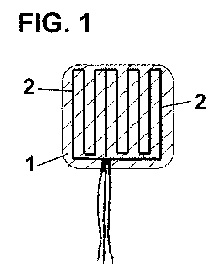Some of the information on this Web page has been provided by external sources. The Government of Canada is not responsible for the accuracy, reliability or currency of the information supplied by external sources. Users wishing to rely upon this information should consult directly with the source of the information. Content provided by external sources is not subject to official languages, privacy and accessibility requirements.
Any discrepancies in the text and image of the Claims and Abstract are due to differing posting times. Text of the Claims and Abstract are posted:
| (12) Patent Application: | (11) CA 3029861 |
|---|---|
| (54) English Title: | VOLATILE SUBSTANCE EVAPORATION DEVICE |
| (54) French Title: | ELEMENT D'EVAPORATION DE SUBSTANCES VOLATILES |
| Status: | Examination |
| (51) International Patent Classification (IPC): |
|
|---|---|
| (72) Inventors : |
|
| (73) Owners : |
|
| (71) Applicants : |
|
| (74) Agent: | ROBIC AGENCE PI S.E.C./ROBIC IP AGENCY LP |
| (74) Associate agent: | |
| (45) Issued: | |
| (86) PCT Filing Date: | 2017-07-04 |
| (87) Open to Public Inspection: | 2018-01-11 |
| Examination requested: | 2022-06-28 |
| Availability of licence: | N/A |
| Dedicated to the Public: | N/A |
| (25) Language of filing: | English |
| Patent Cooperation Treaty (PCT): | Yes |
|---|---|
| (86) PCT Filing Number: | PCT/EP2017/066557 |
| (87) International Publication Number: | EP2017066557 |
| (85) National Entry: | 2019-01-04 |
| (30) Application Priority Data: | ||||||
|---|---|---|---|---|---|---|
|
The invention relates to a volatile substance evaporation device comprising a body (3) containing a liquid and a heating element heating said liquid for evaporating same, wherein said heating element is a heating film (1 ). Furthermore, said body (3) defines an evaporation surface, and said heating film (1 ) preferably has an area substantially the same as the area of said evaporation surface. The invention allows obtaining a homogenous and quick heat distribution.
L'invention porte sur un dispositif d'évaporation de substance volatile comprenant un corps (3) contenant un liquide et un élément chauffant fait d'un film chauffant our chauffer le liquide et l'évaporer. Le corps (3) définit la surface d'évaporation, et le film de chauffage a de préférence une surface identique à la surface de la surface d'évaporation. L'invention permet d'obtenir une répartition de chaleur homogène et rapide.
Note: Claims are shown in the official language in which they were submitted.
Note: Descriptions are shown in the official language in which they were submitted.

2024-08-01:As part of the Next Generation Patents (NGP) transition, the Canadian Patents Database (CPD) now contains a more detailed Event History, which replicates the Event Log of our new back-office solution.
Please note that "Inactive:" events refers to events no longer in use in our new back-office solution.
For a clearer understanding of the status of the application/patent presented on this page, the site Disclaimer , as well as the definitions for Patent , Event History , Maintenance Fee and Payment History should be consulted.
| Description | Date |
|---|---|
| Amendment Received - Response to Examiner's Requisition | 2024-01-12 |
| Amendment Received - Voluntary Amendment | 2024-01-12 |
| Examiner's Report | 2023-09-13 |
| Inactive: Report - No QC | 2023-08-25 |
| Letter Sent | 2022-07-25 |
| Request for Examination Received | 2022-06-28 |
| Request for Examination Requirements Determined Compliant | 2022-06-28 |
| All Requirements for Examination Determined Compliant | 2022-06-28 |
| Common Representative Appointed | 2020-11-07 |
| Inactive: COVID 19 - Deadline extended | 2020-07-02 |
| Common Representative Appointed | 2019-10-30 |
| Common Representative Appointed | 2019-10-30 |
| Inactive: Cover page published | 2019-01-23 |
| Inactive: Notice - National entry - No RFE | 2019-01-22 |
| Application Received - PCT | 2019-01-15 |
| Inactive: IPC assigned | 2019-01-15 |
| Inactive: First IPC assigned | 2019-01-15 |
| National Entry Requirements Determined Compliant | 2019-01-04 |
| Application Published (Open to Public Inspection) | 2018-01-11 |
There is no abandonment history.
The last payment was received on 2024-06-27
Note : If the full payment has not been received on or before the date indicated, a further fee may be required which may be one of the following
Patent fees are adjusted on the 1st of January every year. The amounts above are the current amounts if received by December 31 of the current year.
Please refer to the CIPO
Patent Fees
web page to see all current fee amounts.
| Fee Type | Anniversary Year | Due Date | Paid Date |
|---|---|---|---|
| Basic national fee - standard | 2019-01-04 | ||
| MF (application, 2nd anniv.) - standard | 02 | 2019-07-04 | 2019-07-02 |
| MF (application, 3rd anniv.) - standard | 03 | 2020-07-06 | 2020-07-03 |
| MF (application, 4th anniv.) - standard | 04 | 2021-07-05 | 2021-06-23 |
| Request for examination - standard | 2022-07-04 | 2022-06-28 | |
| MF (application, 5th anniv.) - standard | 05 | 2022-07-04 | 2022-07-01 |
| MF (application, 6th anniv.) - standard | 06 | 2023-07-04 | 2023-06-30 |
| MF (application, 7th anniv.) - standard | 07 | 2024-07-04 | 2024-06-27 |
Note: Records showing the ownership history in alphabetical order.
| Current Owners on Record |
|---|
| ZOBELE HOLDING S.P.A. |
| Past Owners on Record |
|---|
| JOAQUIM LLORENTE ALONSO |
| MOISES CABALLERO TAPIA |
| SERGIO LUQUE VERA |